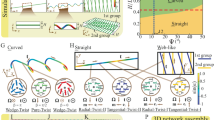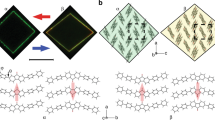Abstract
Collective long-range interactions between micrometre-sized impurities in liquid crystals result from the elastic distortion of the liquid-crystalline order1,2,3,4,5,6,7,8. For substantially smaller polymeric impurities, what is relevant is not the elastic interaction between them but the coupling between the scalar nematic order parameter S and the polymer concentration φ. This coupling originates from local molecular interactions, but becomes long ranged because the total polymer concentration is conserved over the whole sample. Here, we propose a new mechanism by which the spatial variation of S generates a force, mediated by the coupling between S and φ, that transports nanoscale polymeric impurities. We have designed a prototype of a molecular manipulator that moves molecules along spatial variations of the scalar order parameter, modulated in a controlled manner by spot illumination of an azobenzene-doped nematic phase with ultra-violet light. We also demonstrate the use of the manipulator for the measurement of the anisotropic diffusion constant of a polymer in the nematic phase. The manipulator can control the spatial variation of the polymer concentration, thus showing promise for use in the design of hybrid soft materials.
This is a preview of subscription content, access via your institution
Access options
Subscribe to this journal
Receive 12 print issues and online access
$259.00 per year
only $21.58 per issue
Buy this article
- Purchase on Springer Link
- Instant access to full article PDF
Prices may be subject to local taxes which are calculated during checkout



Similar content being viewed by others
References
Poulin, P., Stark, H., Lubensky, T. C. & Weitz, D. A. Novel colloidal interactions in anisotropic fluids. Science 275, 1770–1773 (1997).
Ruhwandl, R. W. & Terentjev, E. M. Long-range forces and aggregation of colloidal particles in a nematic liquid crystal. Phys. Rev. E 55, 2958–2961 (1997).
Yoda, M., Yamamoto, J. & Yokoyama, H. Direct observation of anisotropic interparticle forces in nematic colloids with optical tweezers. Phys. Rev. Lett. 92, 185501–185501 (2004).
Muševič, I. et al. Laser trapping of small colloidal particles in a nematic liquid crystal: Clouds and ghosts. Phys. Rev. Lett. 93, 187801–187801 (2004).
Loudet, J. C., Barois, P. & Poulin, P. Colloidal ordering from phase separation in a liquid-crystalline continuous phase. Nature 407, 611–613 (2000).
Yamamoto, J. & Tanaka, H. Transparent nematic phase in a liquid-crystal-based microemulsion. Nature 409, 321–324 (2001).
Smalyukh, I. I., Lavrentovich, O. D., Kuzmin, A. N., Kachynski, A. V. & Prasad, P. N. Elasticity-mediated self-organization and colloidal interactions of solid spheres with tangential anchoring in a nematic liquid crystal. Phys. Rev. Lett. 95, 157801–157801 (2005).
Muševič, I., Škarabot, M., Tkalec, U., Ravnik, M. & Žumer, S. Two-dimensional nematic colloidal crystals self-assembled by topological defects. Science 313, 954–958 (2006).
Tatarkova, S. A., Burnham, D. R., Kirby, A. K., Love, G. D. & Terentjev, E. M. Colloidal interactions and transport in nematic liquid crystals. Phys. Rev. Lett. 98, 157801–157801 (2007).
Kleman, M. & Lavrentovich, O. D. Soft Matter Physics: An Introduction (Springer-Verlag, 2003).
Anderson, V. J., Terentjev, E. M., Meeker, S. P., Crain, J. & Poon, W. C. K. Cellular solid behaviour of liquid crystal colloids. 1. Phase separation and morphology. Eur. Phys. J. E 4, 11–20 (2001).
Matsuyama, A. & Kato, T. Phase separations and orientational ordering of polymers in liquid crystal solvents. Phys. Rev. E 59, 763–770 (1999).
Kikuchi, H., Yokota, M., Hisakado, Y., Yang, H. & Kajiyama, T. Polymer-stabilized liquid crystal blue phases. Nature Mater. 1, 64–68 (2002).
Ikeda, T. Photomodulation of liquid crystal orientations for photonic applications. J. Mater. Chem. 13, 2037–2057 (2003).
Grier, D. G. A revolution in optical manipulation. Nature 424, 21–27 (2003).
Takanishi, Y., Yoshimoto, M., Ishikawa, K. & Takezoe, H. Development of the nematic liquid crystal compounds derived from phenyl acetylene group with large birefringence. Mol. Cryst. Liq. Cryst. 331, 619–625 (1999).
Duhr, S. & Braun, D. Why molecules move along a temperature gradient. Proc. Natl Acad. Soc. 103, 19678–19682 (2006).
Tyrrell, H. J. V. & Harris, K. R. Diffusion in Liquids: A Theoretical and Experimental Study (Butterworth, 1984).
Hara, M., Ichikawa, S., Takezoe, H. & Fukuda, A. Binary mass diffusion constants in nematic liquid crystals studied by forced Rayleigh scattering. Jpn. J. Appl. Phys. 23, 1420–1425 (1986).
Etchegoin, P. Fluorescence photobleaching recovery spectroscopy in a dye doped nematic liquid crystal. Phys. Rev. E 59, 1860–1867 (1999).
Link, S., Chang, W-S., Yethiraj, A. & Barbara, P. F. Anisotropic diffusion of elongated and aligned polymer chains in a nematic solvent. J. Phys. Chem. B 110, 19799–19803 (2006).
Acknowledgements
The authors are very grateful to S. Ujiie for providing the azobenzene derivatives and to J. Lagerwall for his kind proofreading and helpful comments on this manuscript. This work was partly supported by a Grant-in-Aid for Scientific Research on Priority Area ‘Non-equilibrium soft matter physics’, a Grant-in-Aid for Scientific Research (A) (No. 18204037), a Grant-in-Aid for Young Scientists (B) (No. 21740312), a Grant-in-Aid for the Global COE Program ‘The Next Generation of Physics, Spun from Universality and Emergence’ from the Ministry of Education, Culture, Sports, Science and Technology (MEXT) of Japan, the Toray Science Foundation and the Murata Science Foundation.
Author information
Authors and Affiliations
Contributions
J.Y. conceived the initial idea. S.S. designed and conducted the experiments and analysed the results. Y.T. advised on the experiments. All authors discussed the results and implications, and wrote and commented on the manuscript at all stages.
Corresponding authors
Ethics declarations
Competing interests
The authors declare no competing financial interests.
Supplementary information
Supplementary Information
Supplementary Information (PDF 714 kb)
Rights and permissions
About this article
Cite this article
Samitsu, S., Takanishi, Y. & Yamamoto, J. Molecular manipulator driven by spatial variation of liquid-crystalline order. Nature Mater 9, 816–820 (2010). https://doi.org/10.1038/nmat2853
Received:
Accepted:
Published:
Issue Date:
DOI: https://doi.org/10.1038/nmat2853
This article is cited by
-
Tunable templating of photonic microparticles via liquid crystal order-guided adsorption of amphiphilic polymers in emulsions
Nature Communications (2024)
-
Fluorescence microscopy reveals molecular localisation at line defects in nematic liquid crystals
Scientific Reports (2016)
-
Manipulation and assembly of small objects in liquid crystals by dynamical disorganizing effect of push-pull-azobenzene-dye
Scientific Reports (2013)
-
Liquid crystals: A molecular transporter
NPG Asia Materials (2011)



